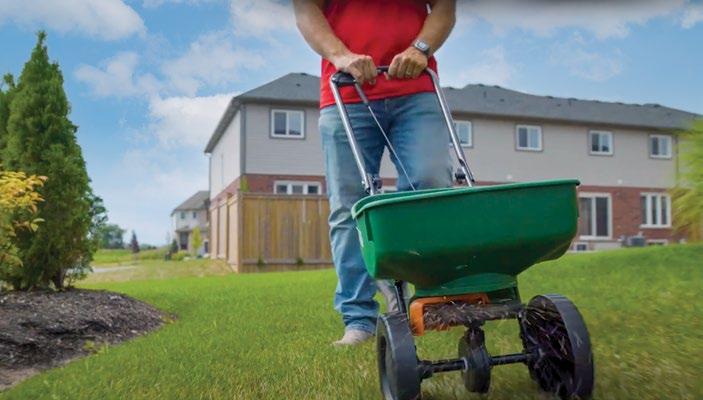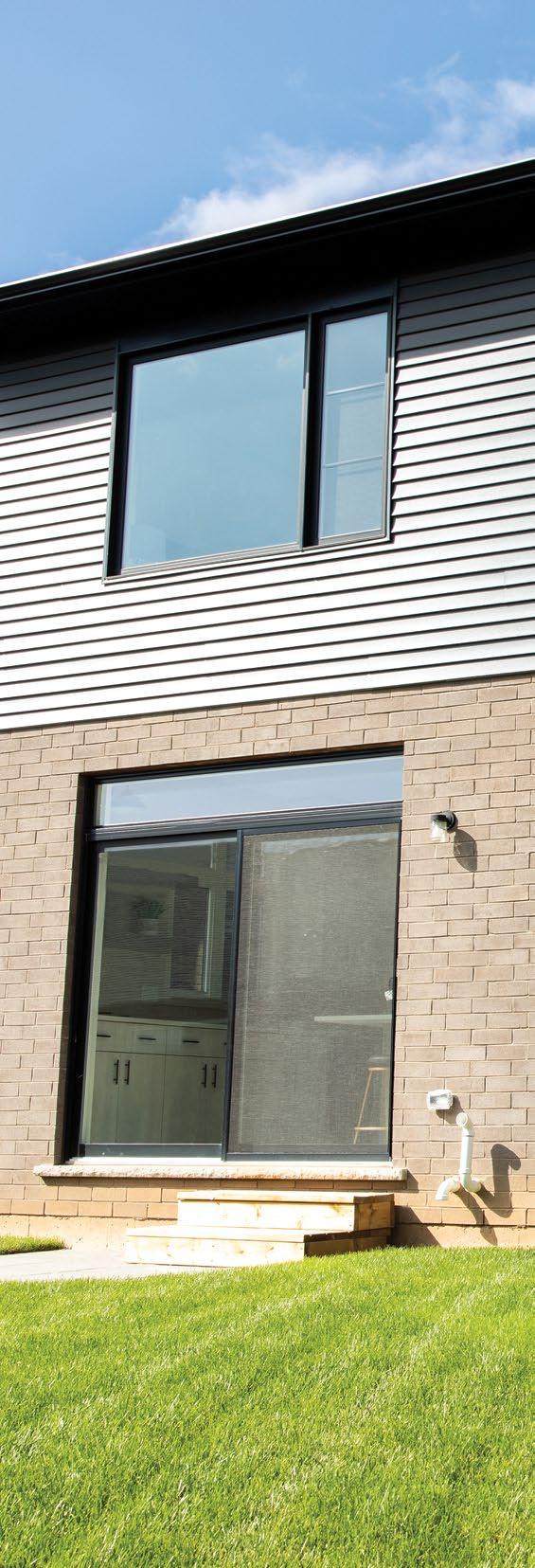CARING FOR YOUR HOME
WELCOME TO YOUR MOUNTAINVIEW HOME

A STEP-BY-STEP GUIDE
TIPS FOR SOD, FENCES AND MORE ESSENTIAL SEASONAL MAINTENANCE
WARRANTIES
WE HAVE YOU COVERED

IN THE KNOW!
We understand that purchasing a new home is one of the biggest investments and decisions in your life. That is why we work so hard to make the journey as stress-free and enjoyable as possible, which includes caring for your home, even once you are all moved in! We hope this guide will be a valuable resource to you as the years go by in your new home, helping you take the very best care of your investment and enjoying it for years and years to come.
Thank you from our family to yours,
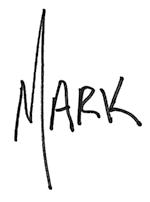 Mark Basciano President, Mountainview Building Group
Mark Basciano President, Mountainview Building Group
MOUNTAINVIEW MYHOME TRACKER
Putting you in the driver’s seat
The Mountainview MyHome Tracker is your personal comprehensive online portal where you have complete access to your new home purchase information. Available online, 24/7, MyHome Tracker puts you in the driver’s seat by allowing you to keep track of service requests and history of your Mountainview home!
If you require service for your home, please enter the items in MyHome Tracker or submit a request to your Service Coordinator: at (289) 407-2197 or service@mountainview.com.
Once service items have been entered into our system, you will be able to track their progress by logging into MyHome Tracker. Here, you will also be able to view information on how to care for the various components in your home. Your login and password was sent to you from ilove@mountainview.com with your Agreement of Purchase and Sale. If you need your login and password resent please contact us at 905-688-3100.
www.mountainview.com
Login: Password:
20-DAY VISIT
The 20-Day Visit is our way of ensuring you are happy with your new home. This walkthrough takes place AFTER you have moved in and is with the homeowner, site super and site assistant. This visit is booked at the Pre-Delivery Inspection with your Service Coordinator.
At the visit, we will:
• Review all of the Pre-Delivery Inspection items and ensure they have been taken care of.
• Review the operation of the various mechanical systems in the home.
• Note any further items that need to be addressed for future follow up.
• Address any questions you may have about how items in your home work!

DID YOU KNOW?
You can request service directly from Mountainview at any time. Mountainview will repair warrantable items whether or not they were submitted to Tarion on time.
WARRANTIES

TARION WARRANTY
Tarion and Mountainview have you covered
Tarion is a private, not-for-profit consumer protection organization established by the Ontario Government in 1976 to administer the province’s New Home Warranty Program. You will be hearing from Tarion regarding a 30-Day Form, Year-End Form and Second-Year Form. These forms are used to list any remaining deficiencies at the end of Tarion’s 30-Day, One-Year, Two-Year, and Seven-Year Warranties.
To complete the Tarion forms, you must sign up for a Tarion MyHome account at https://myhome.tarion.com/hop . You will need your Tarion Warranty Certificate, which was emailed to you prior to closing from ilove@mountainview.com
Remember, you can request service directly from Mountainview at any time, and Mountainview will repair warrantable items whether or not they were submitted to Tarion on time.
YOUR ROLE, YOUR BUILDER’S ROLE AND TARION’S ROLE
Your Role as a Homeowner
• Understand your warranty coverage and the process for making warranty service requests and claims
• Participate in the pre-delivery inspection (PDI) by making note of incomplete, damaged or missing items and learning how to operate your home’s systems
• Properly maintain your home in order to preserve your warranty
• Bring any warranty service requests to your builder’s attention in writing as soon as possible
• Provide your builder with reasonable access to your home to investigate and address warranty service requests
• If you need warranty assistance from Tarion, ensure that your claim is submitted within the appropriate timelines
Our Role as Your Builder
• Ensure that your home is built properly. This means that it is constructed in accordance with Ontario’s Building Code, is fit for habitation, and is free from defects in workmanship and materials and major structural defects
• Provide you with information about your warranty coverage at the time of purchase
• Conduct a pre-delivery inspection (PDI) with you on or before the closing date and explain how the various systems in your home work
• Provide you with a warranty certificate upon your home’s completion which indicates when your new home warranty takes effect
• Be reasonably accessible to you to address customer service issues, including investigating issues with your home to determine if they are covered by the warranty
• Resolve valid warranty requests in a timely manner by performing repairs or offering an acceptable alternative resolution
Tarion’s Role
• Administer the MyHome online portal, which allows homeowners to manage their warranty and report defects to the builder and Tarion
• Facilitate the fair resolution of disputes between homeowners and builders over warranty coverage, repairs, or customer service
• Assess warranty claims to determine if they are valid either through an on-site inspection or an alternative method of investigation
• In cases where a builder fails to address a valid warranty claim, resolve the claim directly with the homeowner either through compensation or repairs by a third party
• Manage a guarantee fund to protect new home buyers, out of which compensation for warranty claims is paid
WARRANTY EXCLUSIONS
Some items are not be covered by the Statutory Warranty, including the following:
Homeowner action/involvement
Normal wear and tear
Third-party damage
Secondary damage
Supplementary warranties/agreements
Refer to MyHome Tracker for details and additional information on these items.
30-DAY FORM
You can submit a 30-Day Form during the first 30 days of possession. Use this form to list any unresolved warranty items you and your builder identified during your pre-delivery inspection, as well as any new items that have arisen since you took possession of your home. You can submit only one 30-Day Form, so make sure you include all of the warranty items that you want to report.
ONE-YEAR WARRANTY
Your home’s statutory One-Year Warranty coverage begins on the date you take possession of the home and ends on the day before the first anniversary of this date.
The one-year warranty is provided by your builder and it requires that the home be:
• Constructed in a workmanlike manner and free from defects in material
• Fit for habitation
• Constructed in accordance with the Ontario Building Code
• Free of major structural defects
• The statutory warranties remain in effect even if the home is sold
GET ONLINE!
Accessing your MyHome Tracker account to find information on warranties, maintenance and service is as easy as 1 - 2 - 3! Here’s how!
Visit mountainview.com and select “MyHome Tracker” from the navigational menu. Use your login and password when prompted. Once in your account, use the top menu and submenus to find the information you need!

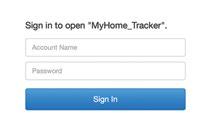
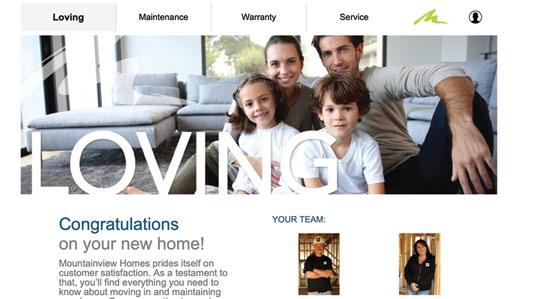
Visit MyHome Tracker for additional details and for quick links to information on the Construction Performance Guidelines and reasonable tolerances that should be expected.

YOU KNOW?
You can find helpful quick links and additional support in MyHome Tracker! DID
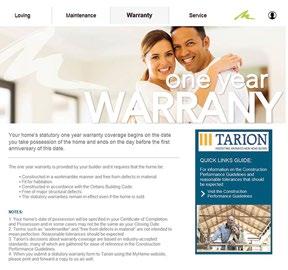
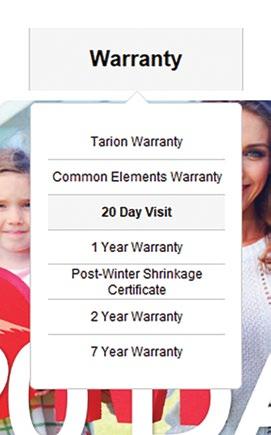
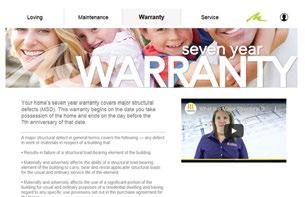

TWO-YEAR WARRANTY
Your home’s statutory Two-Year Warranty coverage begins on the date you take possession of the home and ends on the day before the second anniversary of this date.
The Two-Year Warranty is provided by your builder and covers:
• Water penetration through the basement or foundation walls
• Defects in materials, including windows, doors and caulking such that the building envelope of the home prevents water penetration
• Defects in work and materials in the electrical, plumbing and heating delivery and distribution systems
• Defects in work or materials which result in the detachment, displacement or deterioration of exterior cladding (such as brickwork, aluminum or vinyl siding)
• Violations of the Ontario Building Code affecting health and safety (including, but not limited to, violations relating to fire safety and the structural adequacy of the home)
Visit MyHome Tracker for additional details on the two-year warranty.
SEVEN-YEAR WARRANTY
Your home’s Seven-Year Warranty covers major structural defects (MSD). This warranty begins on the date you take possession of the home and ends on the day before the seventh anniversary of that date.
A major structural defect in general terms covers the following — any defect in work or materials in respect of a building that:
• Results in failure of a structural load-bearing element of that building
• Materially and adversely affects the ability of a structural load-bearing element of the building to carry, bear and resist applicable structural loads for the usual and ordinary service life of the element
• Materially and adversely affects the use of a significant portion of the building for usual and ordinary purposes of a residential dwelling and having regard to any specific use provisions set out in the purchase agreement for the home
Visit MyHome Tracker for additional details on the Seven-Year Warranty.
INFORMATION & CARE SUMMARY
Your home maintenance at a glance
With proper care and maintenance, your Mountainview home will bring you years of enjoyment. MyHome Tracker can help keep you on top of the various components of your home. Log on to your account to find detailed information on care, maintenance and warrantability for the following:
Acrylic tubs & showers
Air conditioning
Alarm systems
Assumption
Brickwork
Cabinetry
Carpeting
Central vac systems
Ceramic tiles
Decks and fencing
Driveway paving
Drywall
Electrical
Exterior caulking
Exterior locks
Exterior woodwork
Fireplaces
Foundation walls
Garage overhead doors
Hardwood flooring & laminate flooring
Heating and ventilation
Insulation
Interior & exterior concrete slabs
Landscaping
Lighting
Lot grading
Painting
Plan of survey
Plumbing and sump pumps
Precast concrete slabs
Roof shingles
Siding, soffits, facia & trough
Telephone & cable T.V. rough-ins
Trimwork
Windows & exterior doors
FRIENDLY REMINDERS
In addition to the wealth of information found in MyHome Tracker, you will also see reminders for repair, maintenance, and warranties directly on the home page!


SEASONAL MAINTENANCE CHECKLIST
ADJUST CABINET DOORS
Adjust cabinet doors and drawers on a yearly basis. Level doors and tighten loose screws.
CHECK THE ATTIC
Take a look in the attic for anything that may have changed over the winter season.
CHECK THE CAULKING
Check the exterior caulking for air and water leaks.
CHECK THE GFCIS
Check, test, and reset the ground fault circuit interrupter at the exterior outlets to make sure they are working properly and there is power to the outlets.
CHECK THE HOT WATER TANK
Check the hot water tank for leaks.
CHECK THE ROOF
Check the roof for loose or cracked shingles.
CLEAN THE FURNACE FILTER
The furnace filter needs to be replaced on a regular basis to maintain a healthy environment in the home. We recommend every 3 months at a minimum. A blocked furnace filter can cause the furnace to shut down and to stop providing heating and cooling to the home.
CLEAN THE HEAT RECOVERY VENTILATOR
Heat recovery ventilators require regular maintenance. We recommend that you do the following every two months: clean your filters with tap water, rinse out the aluminum core with a garden hose (do not use a pressure washer or dishwasher), blow out the drain tube, and pop off the air intake cap on the exterior wall so you can brush off the intake. We recommend that you do the following every year: have the input and output air flows balanced by a certified contractor.
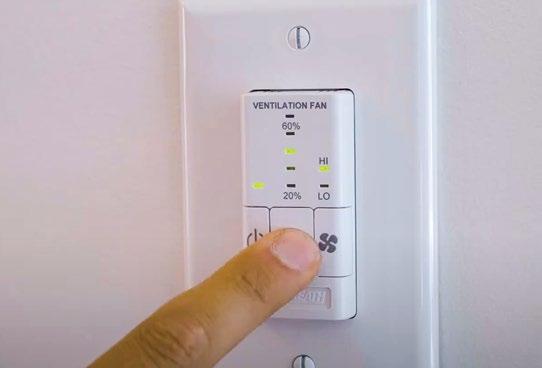
FERTILIZE THE LAWN
MID TO END OF APRIL: Apply a high nitrogen fertilizer at 1.5 times the rate recommended on the bag (e.g. 28-4-14). END OF MAY: apply a balanced fertilizer (e.g. 15-15-15). END OF AUGUST TO MID-SEPTEMBER: Apply a balanced fertilizer. MID-OCTOBER: Apply a low nitrogen fertilizer (e.g. 5-20-20).
If grubs are prominent in the area, two applications of a grub killer are a must. One application at the end of April, and one in early to mid September. All of the above applications will require a two hour watering if there is no rain within 24 hours of the application. For all applications of fertilizers, a rotary spreader must be used for even coverage. Sod should be cut to 1.5" to 2" in length. Cutting it shorter than this will cut into the crown of the plant and cause it to look yellow instead of green.
PREVENT WEEDS
To help prevent the spread of weeds such as dandelions, use a natural product like corn gluten that can be applied right after the winter snow has melted. Corn gluten impedes the germination of seeds as they begin to sprout. It is only effective when used before the first signs of weeds. Corn gluten can be purchased in pure form or mixed with fertilizer. It may not be available when the snow melts so it should be purchased in the fall and stored through the winter.
INSPECT BACKFLOW PREVENTER
All municipalities require that sanitary sewer backflow preventers be installed where the sanitary sewer exits the house in the basement. The backflow preventers should be inspected twice a year to ensure the flap is operating correctly and will close in the case of an emergency.
TEST SAFETY ALARMS
Test the smoke detectors and CO detectors to make sure they are working properly.
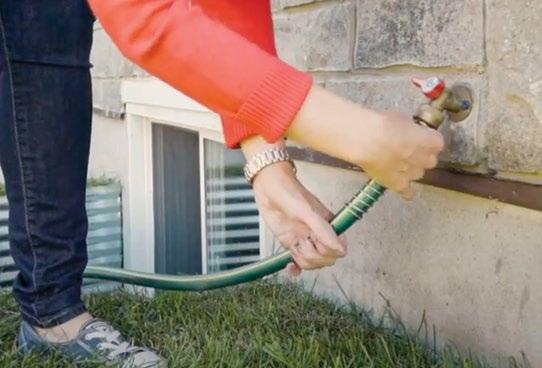
INSPECT THE SUMP PUMP
Inspect the sump pump to make sure the unit is plugged in, has power, and the alarm switch is turned on if applicable). The pump can be tested by pouring water into the pit. A spare sump pump should be kept close to the sump pump pit in the case of a sump pump failure. Sump pumps can be changed out in under 10 minutes when they fail. Spare sump pumps can be purchased from Bardon Supplies.
SET THE HRV SETTINGS
Your home was built with a Heat Recovery Ventilator (HRV) in the basement, the dehumidistat which is located next to your thermostat should have the fan light turned on, the dehumidistat light set to the 80% or summer position, and the speed light off. The fan light should be left on when the house is being cooled with air conditioning to provide ventilation and clean air. The fan light may be turned off if windows are being left open continually as a means of cooling the house and providing fresh air. If the HRV is a Lifebreath unit, the dehumidistat light can be left at the 30% or winter position as the unit will automatically remain at the low speed setting when the temperature outside is above 15 degrees Celsius.
SUBMIT THE “POST-WINTER SHRINKAGE CERTIFICATE”
During the first winter, dry air will cause new homes to settle and shrink. The moisture in the concrete, drywall and wood will dry out to the cold dry air outside. Caulked areas where stairs meet the wall, and tubs meet tile decks will shrink and the caulking will pull away. Doors will shift slightly, locks may no longer line up, and drywall screws may pull in on the drywall. Every home owner is entitled to submit a single “Post-Winter Shrinkage Certificate” to Mountainview Homes to deal with these nonwarrantable shrinkage related items.
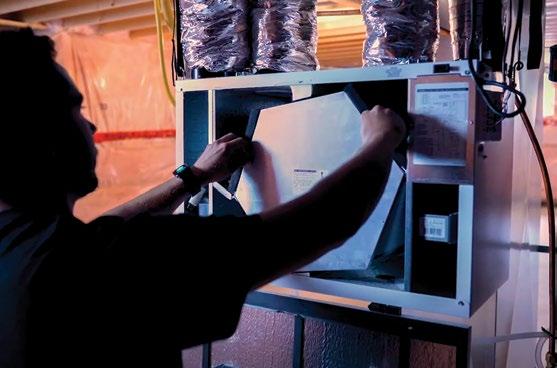
AIR OUT THE BASEMENT
Open the windows and air out the basement on a dry sunny day.
CHECK THE AIR CONDITIONER
If you have an air conditioner, clean the unit and make sure it is clear of plants and debris.
CLEAN THE FURNACE FILTER
The furnace filter needs to be replaced on a regular basis to maintain a healthy environment in the home. We recommend every 3 months at a minimum. A blocked furnace filter can cause the furnace to shut down and to stop providing heating and cooling to the home.
CLEAN THE HEAT RECOVERY VENTILATOR
Heat recovery ventilators require regular maintenance. We recommend that you do the following every two months: clean your filters with tap water, rinse out the aluminum core with a garden hose (do not use a pressure washer or dishwasher), blow out the drain tube and pop off the air intake cap on the exterior wall so you can brush off the intake. We recommend that you do the following every year: have the input and output air flows balanced by a certified contractor.
FERTILIZE THE LAWN
MID TO END OF APRIL: Apply a high nitrogen fertilizer at 1.5 times the rate recommended on the bag (e.g. 28-4-14). END OF MAY: apply a balanced fertilizer (e.g. 15-15-15). END OF AUGUST TO MID-SEPTEMBER: Apply a balanced fertilizer. MID-OCTOBER: Apply a low nitrogen fertilizer (e.g. 5-20-20).
If grubs are prominent in the area, two applications of a grub killer are a must. One application at the end of April, and one in early to mid September. All of the above applications will require a two hour watering if there is no rain within 24 hours of the application. For all applications of fertilizers, a rotary spreader must be used for even coverage. Sod should be cut to 1.5" to 2" in length. Cutting it shorter than this will cut into the crown of the plant and cause it to look yellow instead of green.
WATER THE GRASS
On average, a lawn needs about 1" of water a week during the growing season, either from rain or irrigation. This 1" of water normally soaks the soil to a depth of 4" to 6", which allows the water to reach deep into the root system.
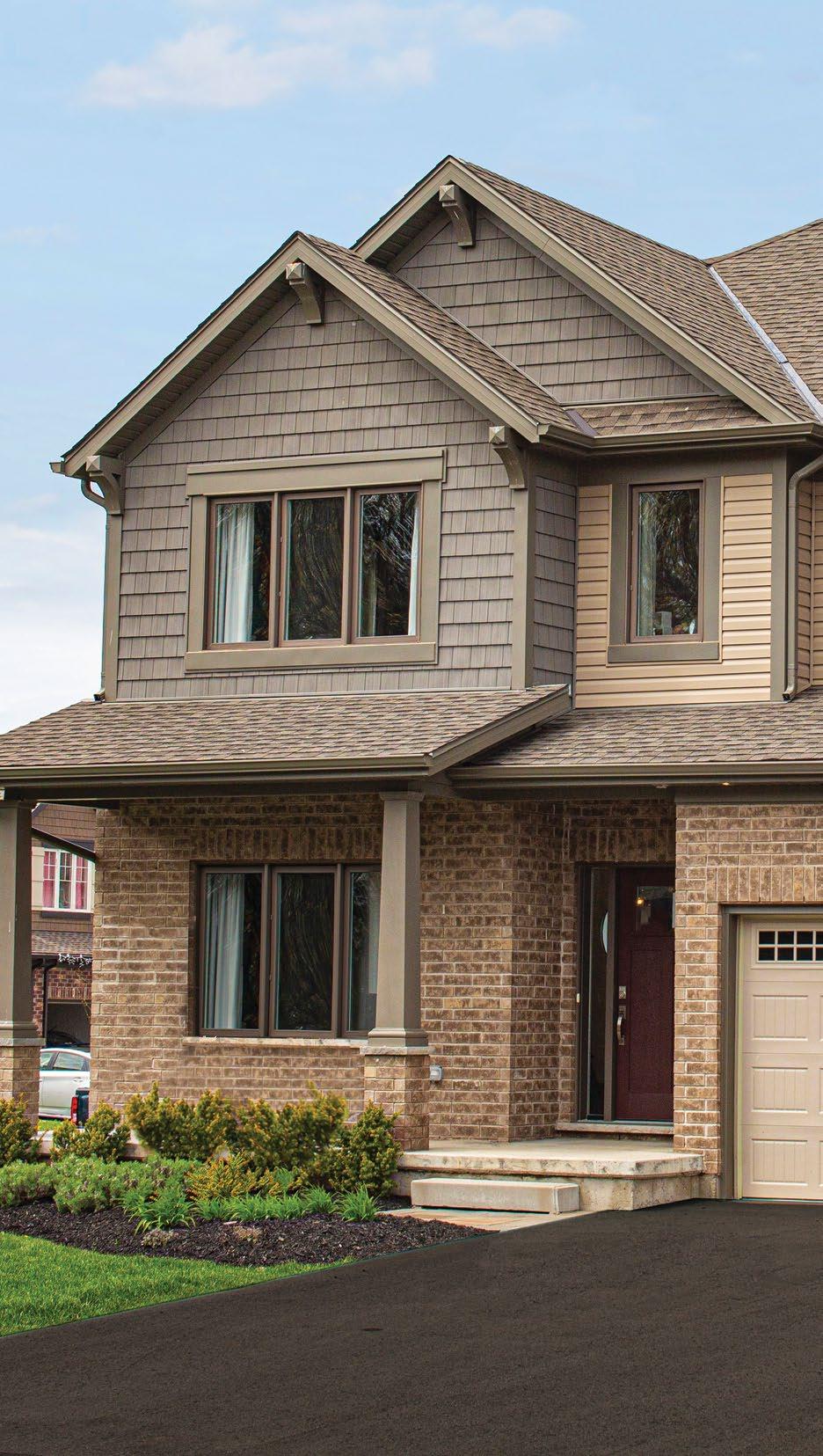
BUILT TO LAST
Your home has been built to Mountainview’s meticulously high standards, and with proper maintenance, will provide you and your family with many years of enjoyment.
WINTER
CALL FOR FURNACE/HEAT RECOVERY
VENTILATOR (HRV) SERVICE
Furnaces and HRVs require yearly maintenance from a certified technician. Call for service for the furnace and HRV before the heating season begins.
CHECK DRYER VENT
Check the clothes dryer vent and clear any lint or obstructions to make sure the air is flowing properly.
CHECK FLOOR DRAINS
Check the P-traps in the floor drains and make sure they have water in them to prevent sewer gases from entering the house.
CHECK THE GARAGE OVERHEAD DOOR
Inspect the garage overhead door operation, inspect the tracks, and lubricate the bearings.
CHECK GFCIS
Check, test, and reset the ground fault circuit interrupter at the exterior outlets to make sure they are working properly and there is power to the outlets.
CHECK EAVESTROUGHS AND DOWNSPOUTS
Check the exterior eavestroughs and downspouts to make sure they are clear of leaves and other obstructions. Make sure downspouts drain water away from the house and can handle ice buildup in the coming winter.
CLEAN THE FURNACE FILTER
The furnace filter needs to replaced on a regular basis to maintain a healthy environment in the home. We recommend every 3 months at a minimum. A blocked furnace filter can cause the furnace to shut down and to stop providing heating and cooling to the home.
CLEAN THE HEAT RECOVERY VENTILATOR
Heat recovery ventilators require regular maintenance. We recommend that you do the following every two months: clean your filters with tap water, rinse out the aluminum core with a garden hose (do not use a pressure washer or dishwasher), blow out the drain tube, and pop off the air intake cap on the exterior wall so you can brush off the intake. We recommend that you do the following every year: have the input and output air flows balanced by a certified contractor.
DRAIN THE OUTSIDE WATER LINES
When turning off the water to the exterior water lines, please take the following steps: 1) Start by turning off the inside valve that is located near the outside wall adjacent to the outside tap. 2) Leave the outside tap in the open position. 3) Disconnect any hoses from the outside tap. 4) Open the bleed valve on the inside valve to drain any remaining water in the line between the inside valve and the outside tap. 5) Pull down on the post inside the back flow preventer on the outside tap (needle nose pliers may be required) to allow water in the line to drain out.
FERTILIZE THE LAWN
MID TO END OF APRIL: Apply a high nitrogen fertilizer at 1.5 times the rate recommended on the bag (e.g. 28-4-14). END OF MAY: apply a balanced fertilizer (e.g. 15-15-15). END OF AUGUST TO MID-SEPTEMBER: Apply a balanced fertilizer. MID-OCTOBER: Apply a low nitrogen fertilizer (e.g. 5-20-20).
If grubs are prominent in the area, two applications of a grub killer are a must. One application at the end of April, and one in early to mid September. All of the above applications will require a two hour watering if there is no rain within 24 hours of the application. For all applications of fertilizers, a rotary spreader must be used for even coverage. Sod should be cut to 1.5" to 2" in length. Cutting it shorter than this will cut into the crown of the plant and cause it to look yellow instead of green.
INSPECT BACKFLOW PREVENTER
All municipalities require that sanitary sewer backflow preventers be installed where the sanitary sewer exits the house in the basement. The backflow preventers should be inspected twice a year to ensure the flap is operating correctly and will close in the case of an emergency.
INSPECT THE SUMP PUMP
Inspect the sump pump to make sure the unit is plugged in, has power, and the alarm switch is turned on if applicable). The pump can be tested by pouring water into the pit. A spare sump pump should be kept close to the sump pump pit in the case of a sump pump failure. Sump pumps can be changed out in under 10 minutes when they fail. Spare sump pumps can be purchased from Bardon Supplies.
SEAL CONCRETE SURFACES
Removal of salt deposits from concrete surfaces is part of the normal maintenance of your home. The application of a concrete sealer on the front porch and at the exposed area of a garage floor is the best way to increase the durability of these concrete surfaces and will help prevent flaking and scaling. We recommend that home owners apply a concrete sealer as per manufacturer’s instructions in the fall.
SET HRV SETTINGS
If your home was built with a Heat Recovery Ventilator (HRV) in the basement, the dehumidistat which is located next to your thermostat should have the fan light turned on, the dehumidistat light set to the 30% or winter position (40% if it feels too dry - higher settings increase the risk of mold), and the speed light off unless you want to temporarily run the fan at high speed for increased ventilation. A flashing dehumidistat light indicates the fan is running at high speed to meet the desired humidity level. A continuous dehumidistat light indicates the humidity level is lower or equal to the setting. The furnace fan will run at low speed when the HRV fan light is on to evenly distribute fresh air through the home. This will provide the most even temperature and moisture levels through the home, will provide the cleanest air (by continually moving it past the furnace filter), and the least amount of condensation on windows (as the constant air movement can slightly raise the glass temperature).
TEST SMOKE ALARMS
Test the smoke detectors and CO detectors to make sure they are working properly.
CHECK THE AIR DUCTS
Check all floor vents and air ducts to make sure they are clear and air can move freely around them.
CLEAN THE FURNACE FILTER
The furnace filter needs to replaced on a regular basis to maintain a healthy environment in the home. We recommend every 3 months at a minimum. A blocked furnace filter can cause the furnace to shut down and to stop providing heating and cooling to the home.
CLEAN THE HEAT RECOVERY VENTILATOR
Heat recovery ventilators require regular maintenance. We recommend that you do the following every two months: clean your filters with tap water, rinse out the aluminum core with a garden hose (do not use a pressure washer or dishwasher), blow out the drain tube, and pop off the air intake cap on the exterior wall so you can brush off the intake. We recommend that you do the following every year: have the input and output air flows balanced by a certified contractor.
INSPECT THE DOWNSPOUTS
Inspect the rain water downspouts on a regular basis to make sure there is no ice at the bottom that would prevent water from exiting the downspout. Frozen downspouts will be heavy and could collapse.
INSPECT THE FURNACE INTAKE
Inspect the air intake and combustion outlet for the furnace, located on the exterior of the home. Snow and ice can build up and block them which will cause the furnace to shut down.
WATCH FOR ICE DAMS ON THE ROOF
Inspect the roof to see if there is snow or ice building up. When ice forms on the roof shingles, and the underside of the ice starts to melt, water may travel upwards by capillary action and go up and under the shingles. In extreme cases this can cause a roof leak. If possible, the ice should be broken and the snow should be removed to relieve the water pressure that builds up underneath. In some cases it will not be safe to do so and nature will have to take its course. Do not attempt to walk on roof areas covered in snow or ice.
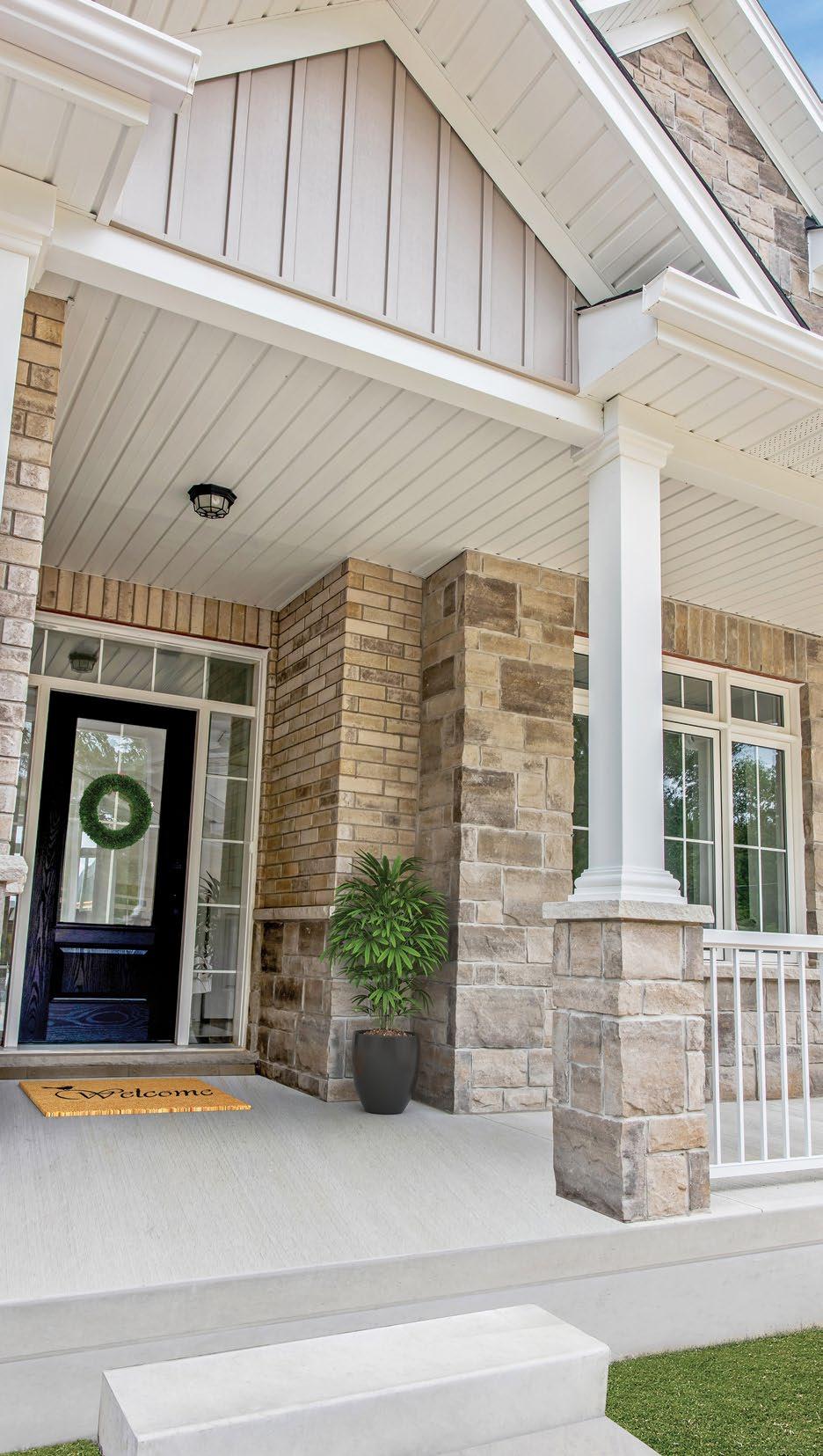
DID YOU KNOW?
Not only does regular maintenance keep your home in good condition, it also protects your warranty rights as a homeowner. When making certain warranty claims, proper maintenance is often a prerequisite.
STICKERS AND TAGS
You may have noticed stickers and tags on the equipment in the basement of your new home. These have been placed for your reference and provide important information about the various equipment and what maintenance is involved for them to all run smoothly. Shown here are some of the labels you might find.

LOOK FOR THE STICKERS AND TAGS WITH IMPORTANT INFORMATION ABOUT THE EQUIPMENT FOUND IN YOUR BASEMENT.
THEY INCLUDE QUICK TIPS ON HOW TO USE AND MA NTAIN THESE ITEMS. FOR MORE INFORMATION PLEASE VISIT WWW.MOUNTAINVIEW.COM AND LOGIN TO MYHOME TRACKER FOR MORE INFORMATION
IN THE EVENT OF A HOME RELATED EMERGENCY AFTER BUSINESS HOURS, CONTACT THE MOUNTAINVEW BUILDING GROUP HEAD OFFICE AT (905)688-3100. THERE IS AN ANSWERING SERVICE THAT WILL CONTACT A MOUNTAINVIEW REPRESENTATIVE TO HELP YOU.
We have added QR codes to our main utility sticker which you can scan using the camera on your smart phone. These will direct you to valuable resources and maintenance videos.
Spring and Summer Maintenance Videos
Fall and Winter Maintenance Videos
We have added stickers and tags to help you easily identify the names of equipment and provide at-a-glance maintenance tips.
NATURAL GASVALVE
LAUNDRY BOX
PRIOR TO APPLIANCE INSTALLATION, REMOVE THE WHITE DRAIN CAP.
SEE DRAIN CAP FOR INSTRUCTIONS.
CENTRAL VAC ROUGH IN DROP FOR FUTURE USE.

FRIDGE LINE SHUT-OFF. LOCKED DOORS
LOCK OUTS ON SIDE DOORS AND PATIO DOORS WHEN GRADING AND SOD S NOT YET COMPLETE, THESE DOORS WILL BE LOCKED FOR SAFETY REASONS.
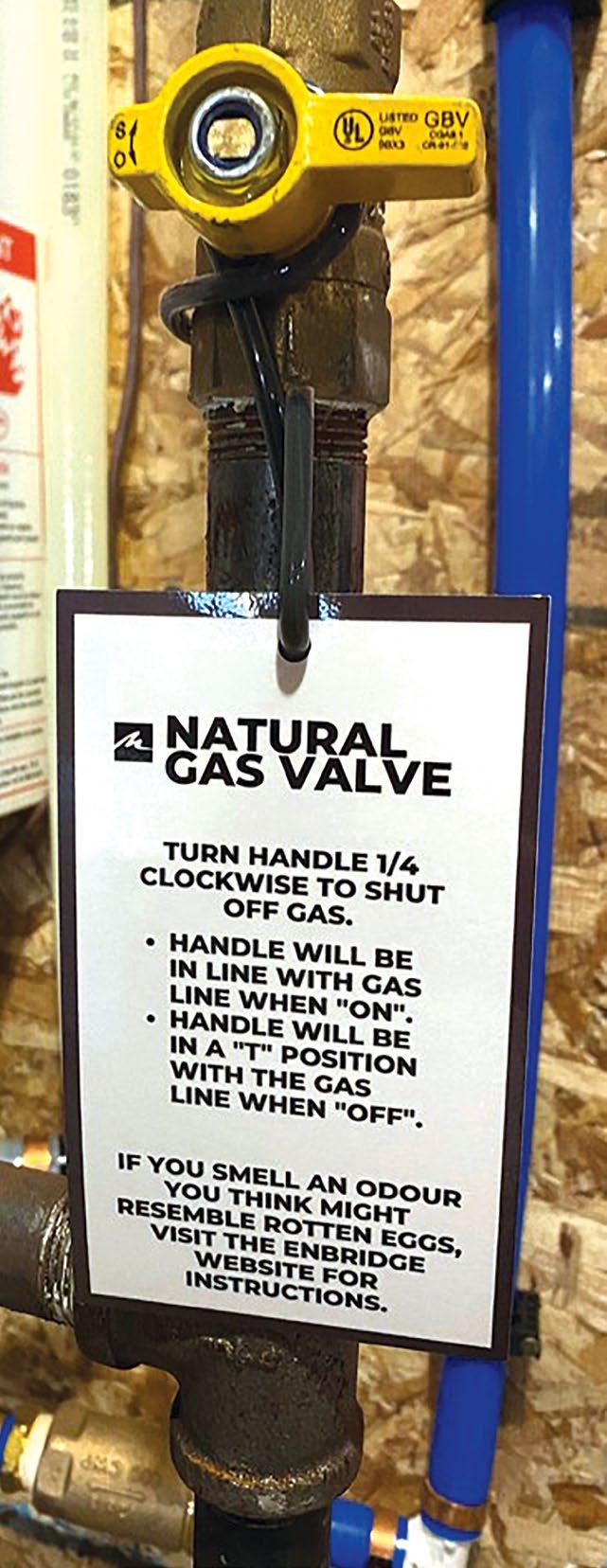
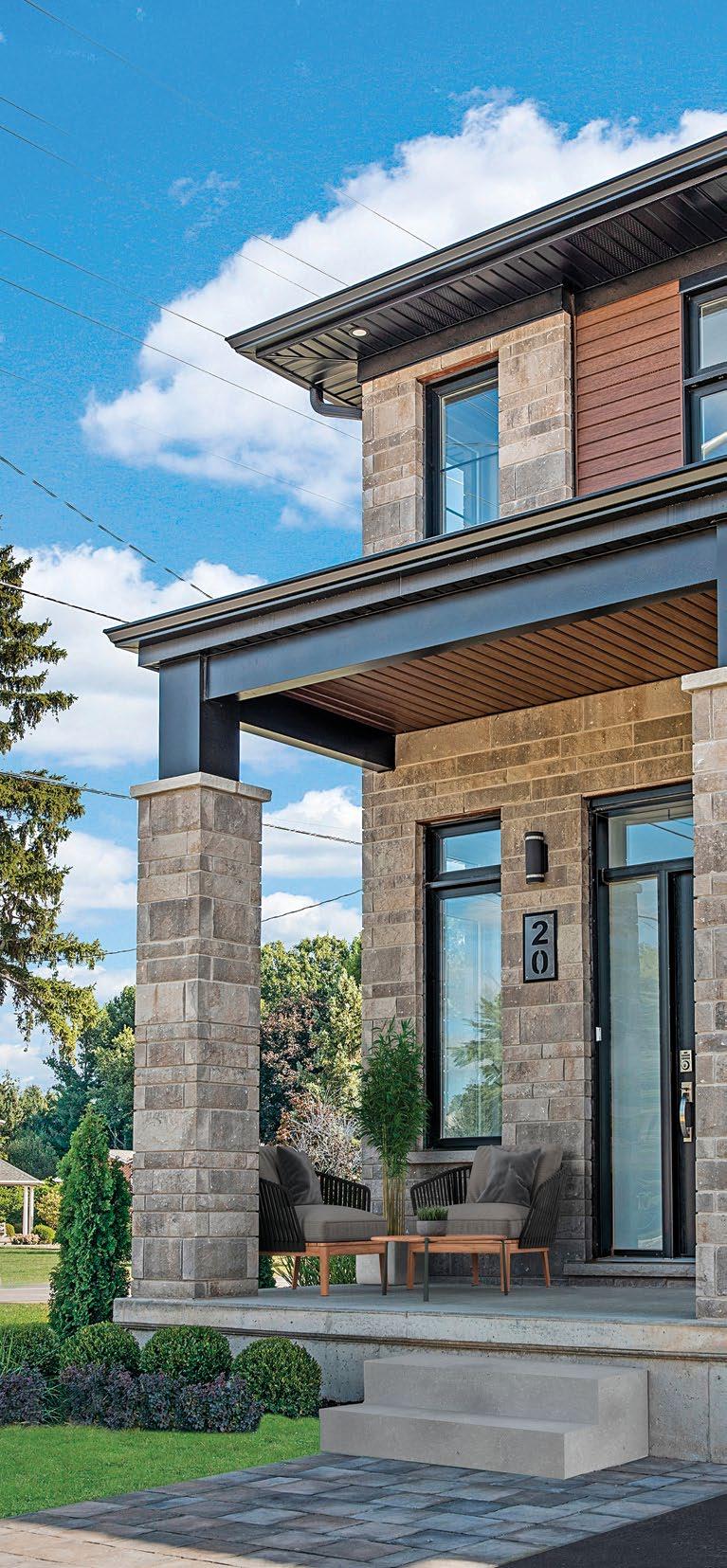
FENCE & DECK TIPS
Before you dig
If you intend to build a fence on your property, we suggest that you hire a legal surveyor to confirm the location of the corners of your property. Property bars are put in place at the time the subdivision is created. After the bars are installed they may become buried or bent. Hiring a legal surveyor is the only way you can confirm the true extent of your property and will save you time and money in the end. Encroaching a fence or other object on others’ property may result in the costly removal of those items. Fence posts should be installed on one side of the swale or the other to avoid blocking the swale and causing standing water.
Anytime you plan to dig, whether it’s digging for fence posts, driveway/sidewalk extensions, or for landscaping, to name a few examples, homeowners MUST call for utility locations.
Ontario One Call will arrange for most locates. If they do not do a particular type of locate they will advise homeowners on who to contact. This service is free of charge but requires up to five working days. No one wants to hit a buried utility. A buried utility may be someone’s lifeline. Hitting a buried utility could cause personal injury or death.
Mountainview cannot guarantee that the location of existing property bars is correct and will not be held responsible for problems with fences that were located using the property bars. Wooden stakes are not property bars and swales do not represent property boundaries.
CONTACT BEFORE YOU DIG!
Ontario One Call
1-800-400-2255
www.on1call.com
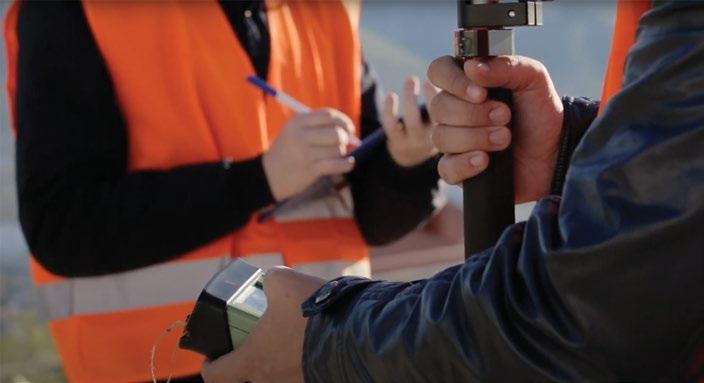
SOD TIPS
Where the green grass grows…
If your house has not yet been graded and sodded, our team will begin sodding houses some time in mid-May. It can take up to two months to grade and sod all of the houses that were moved into during the winter months.
Once your sod is placed, our landscaper will soak it on the first day, but the rest will be your responsibility.
To give your sod the best chance possible, we ask that you keep the sod watered well. This means two-hour per setting waterings for a minimum of two weeks, until the sod starts to root. Additional watering may be required on a day-to-day basis if extreme heat and/or sun conditions exist and early morning watering allows for best results.
Once the sod has rooted, watering can be decreased and we recommend beginning a fertilizer program to ensure a beautiful, lush green lawn.
Cracks or gaps between laid rolls of sod indicate there is not enough moisture being applied. This causes the sod to shrink. The sod should grow back into place once proper moisture levels are attained.
Once the sod has taken root the following fertilizer program is recommended.
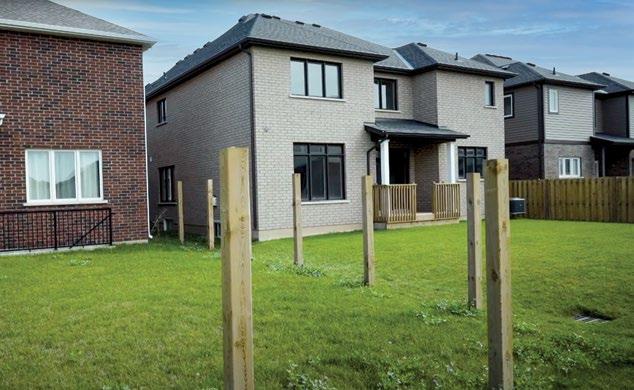
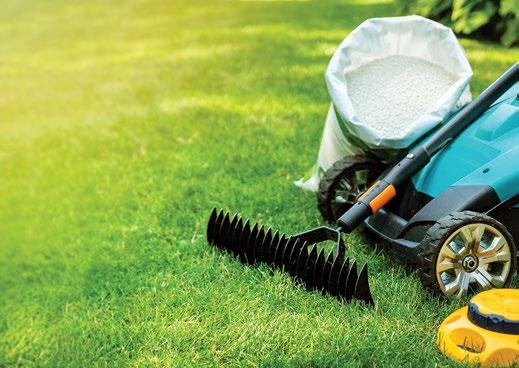
MID TO END OF APRIL: Apply a high nitrogen fertilizer at 1.5 times the rate recommended on the bag (e.g. 28-4-14).
END OF MAY: Apply a balanced fertilizer (e.g. 15-15-15).
END OF AUGUST TO MID-SEPTEMBER: Apply a balanced fertilizer.
MID-OCTOBER: Apply a low nitrogen fertilizer (e.g. 5-20-20).
If grubs are prominent in the area, two applications of a grub killer are a must. One application at the end of April, and one in early to mid-September. All of the above applications will require a two-hour watering if there is no rain within 24 hours of the application. For all applications of fertilizers, a rotary spreader must be used for even coverage.
To help prevent the spread of weeds such as dandelions, use a natural product like corn gluten that can be applied right after the winter snow has melted. Corn gluten impedes the germination of seeds as they begin to sprout. It is only effective when used before the first signs of weeds. Corn gluten can be purchased in pure form or mixed with fertilizer. It may not be available when the snow melts so it should be purchased in the fall and stored through the winter. Sod should be cut to 1.5" to 2" in length. Cutting it shorter than this will cut into the crown of the plant and cause it to look yellow instead of green.
